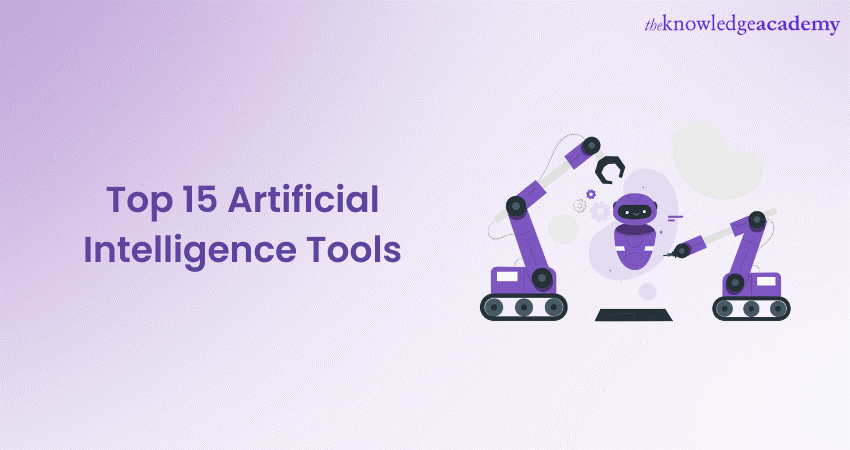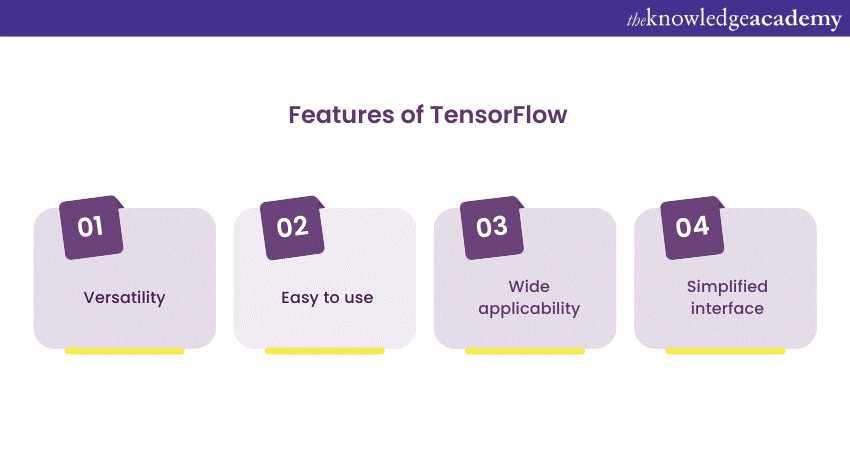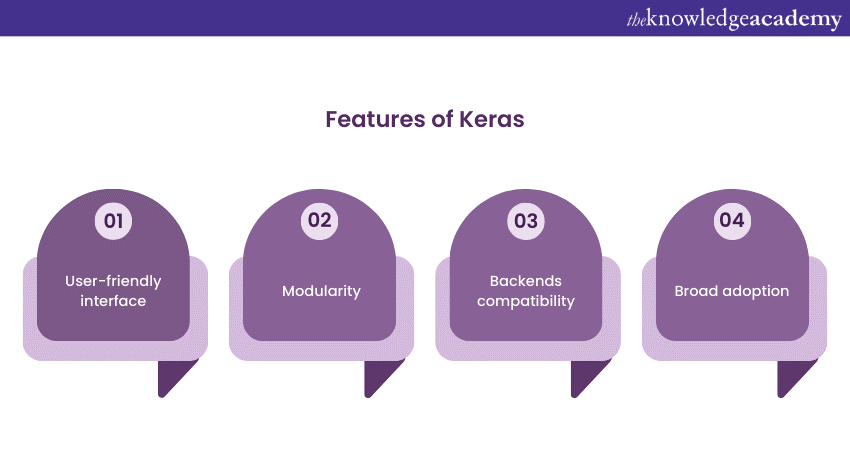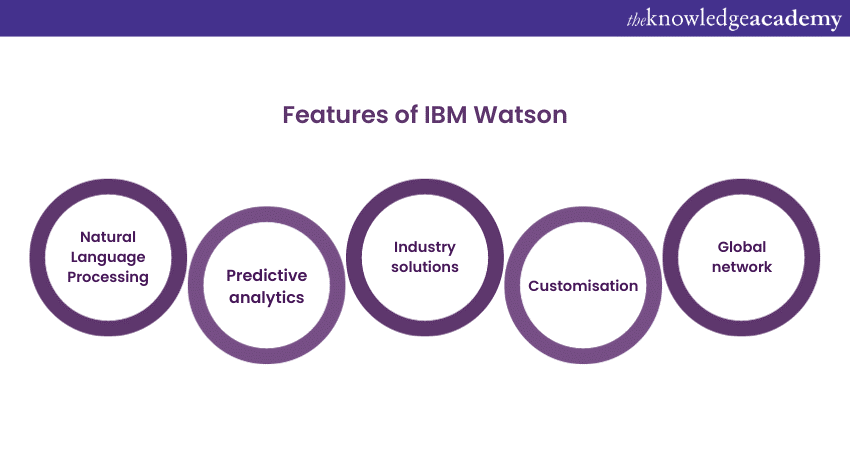We may not have the course you’re looking for. If you enquire or give us a call on 800969236 and speak to our training experts, we may still be able to help with your training requirements.
We ensure quality, budget-alignment, and timely delivery by our expert instructors.

In today’s technology-driven world Artificial Intelligence (AI) stands as a beacon, easing our way out of every complex problem. There are several Artificial Intelligence Tools which come in handy when solving the problems. These tools automate repetitive and labour-intensive tasks, significantly increasing efficiency and reducing human error.
Moreover, they enhance productivity, streamline operations, and optimise processes, enabling companies to deliver better products and services. If you too want to ease your workflow and utilise these tools to your advantage, then this blog is for you. In this blog, we'll explore 15 Artificial Intelligence Tools driving advancements in genomics, drug development, climate science, and so on.
Table of Contents
1) Importance of AI Tools
2) Top 15 Artificial Intelligence Tools
a) TensorFlow
b) PyTorch
c) Scikit-Learn
d) Keras
e) OpenAI GPT-4
f) Microsoft Azure AI
g) Google Cloud AI
h) IBM Watson
i) Amazon SageMaker
j) Caffe
3) Conclusion
Importance of AI Tools
Artificial Intelligence Tools have become crucial in each and every domain. Let’s understand the importance of AI Tools briefly:
a) Driving innovation: Artificial Intelligence Tools are essential for promoting innovation since they make it possible to create cutting-edge ideas and applications.
b) Task automation: They increase productivity and free up human resources for more innovative and tactical activities by automating labour-intensive and repetitive tasks.
c) Data analysis: Large dataset management and analysis, smart conclusion-making, and data-driven decision-making are all made possible by artificial intelligence tools.
d) Competitive advantage: AI Tools offer companies an advantage in today's competitive marketplace by increasing efficiency and improving operations.
e) Personalisation: They enable businesses to provide personalised experiences to customers, leading to higher customer satisfaction.
f) Cost savings: Through automation and optimisation, Artificial Intelligence (AI) Tools contribute to cost savings in various sectors, improving profitability.
g) Scientific advancements: In research, these tools accelerate discoveries and assist in complex data analysis, pushing the boundaries of scientific knowledge.
h) Future-shaping technology: The significance of Artificial Intelligence Tools in 2023 underscores their role as drivers of progress, shaping the future of technology and society.

Top 15 Artificial Intelligence Tools
As you have seen, Artificial Intelligence Tools are now essential resources for various industries, acting as a catalyst for innovation and informed choices. The top AI tools available today offer the following solutions, which are the most productive and efficient:
1) TensorFlow
TensorFlow, created by Google, is an open-source framework renowned for its capabilities in machine learning (ML) and deep learning applications. Here's an in-depth look at TensorFlow:

a) Versatility: TensorFlow's versatility is widely acknowledged. It can adapt to a wide range of AI jobs because it supports many different neural network topologies.
b) Developer's darling: This framework enjoys immense popularity among developers and researchers. Its ease of use and extensive library support make it a favourite choice.
c) Wide applicability: TensorFlow's prowess extends to diverse applications, from image recognition to reinforcement learning and generative adversarial networks.
d) Simplified complexity: It simplifies complex Artificial Intelligence tasks, offering tools and abstractions that facilitate model creation, training, and deployment.
2) PyTorch
Developed by Facebook's AI Research lab, PyTorch is a dynamic and versatile open-source AI framework. It has gained widespread popularity for its unique features and capabilities:
a) Dynamic computational graph: Unlike some other frameworks, PyTorch utilises a dynamic computational graph. This dynamic nature makes it more intuitive for tasks that involve changing network architectures, such as Natural Language Processing (NLP) and computer vision.
b) Researcher's delight: PyTorch is especially favoured by researchers due to its flexibility. It empowers them to experiment with models and iterate quickly, making it an ideal choice for academic and research environments. In the ongoing PyTorch vs TensorFlow debate, PyTorch’s dynamic nature often leads researchers to prefer it for more experimental and flexible model designs.
c) Pythonic syntax: The Pythonic syntax used in PyTorch is clear and short. Because of this, Data Scientists and Developers who are inexperienced with Deep Learning continue to employ it.
d) Deep Learning building blocks: The framework provides a rich set of AI Tools for building Deep Learning models. It supports neural networks, automatic differentiation, and GPU acceleration, among other features.
e) Community support: A vibrant community exists for PyTorch, that helps in its development. By doing this, it is guaranteed to be up to date with the most recent developments in AI science and technology.
3) Scikit-Learn
Scikit-Learn is a powerful and user-friendly open-source Machine Learning library for Python. It is celebrated for its simplicity and effectiveness in implementing ML algorithms and tools. Here are the key aspects of Scikit-Learn:
a) Rich algorithm library: Scikit-Learn offers an extensive library of Machine Learning algorithms. From classic linear regression to advanced support vector machines and Deep Learning, it covers a wide spectrum of techniques.
b) Consistency: The consistency makes it easier to experiment with different models and exchange between different algorithms.
c) Ease of use: Designed with user-friendliness in mind, Scikit-Learn is an excellent choice for both beginners and experts. Its simple and intuitive syntax allows users to implement Machine Learning solutions quickly.
d) Data preprocessing: A wide range of AI techniques, such as data scaling, extraction of features, and choosing features, are available with Scikit-Learn for data preprocessing. By doing this, data preparation for modelling is ensured.
4) Keras
Keras is designed to be user-friendly and efficient for building and training Deep Learning models. It has gained immense popularity in the AI and Machine Learning communities for several reasons:

a) User-friendly interface: Keras prioritises user-friendliness. Its simple and intuitive API allows developers and data scientists to quickly prototype and build deep learning models with minimal code complexity.
b) Modularity: Keras conforms to a modular design concept. It offers an assortment of easily assembleable building parts (layers, activations, optimisers, etc.) for the development of complex artificial neural network structures. This flexibility encourages experimentation and increases flexibility.
c) Backend compatibility: Keras is suitable with a wide range of Deep Learning frameworks, such as Microsoft Cognitive Toolkit (CNTK), TensorFlow, and Theano, due to its database agnostic feature. Users have options and can take advantage of the many benefits of their chosen framework due to this compatibility.
d) Broad adoption: Keras is widely adopted in both research and industry communities. Its ease of use has made it the go-to choose for teaching Deep Learning concepts and quickly implementing research ideas.
5) OpenAI GPT-4
The Generative Pre-Trained Transformer (GPT) series, developed by OpenAI, is now in its fourth version: OpenAI GPT-4. It has the following features:
a) Natural language understanding: GPT-4 boasts advanced language understanding capabilities. It can comprehend and generate human-like text through the Azure OpenAI Service, making it invaluable for tasks like chatbots, content generation, and translation.
b) Multimodal abilities: GPT-4 extends its capabilities beyond text and into the realm of vision. It can process both text and images, enabling applications like image captioning and content synthesis.
c) Continual learning: GPT-4 shows the ability to take up new information and adapt. It's a useful tool for remaining relevant in rapidly changing circumstances since it can adapt to changing language trends and patterns.
d) Research advancements: GPT-4 pushes the boundaries of NLP research. Its architecture and scale contribute to breakthroughs in understanding human languages, enabling improved conversational AI and text generation systems.
e) AI innovation: OpenAI GPT-4 has inspired innovation in various industries, from content creation and recommendation systems to virtual assistants, transforming the way we interact with and utilise AI-powered language models.
Take ChatGPT on your fingertips with our ChatGPT Prompt Engineering Certification Training – join now
6) Microsoft Azure AI
Microsoft Azure AI is a suite of AI services and tools offered by Microsoft. It empowers businesses to build, deploy, and manage AI solutions efficiently.
a) Diverse AI services: Azure AI provides a wide range of AI services, including Machine Learning (ML), computer vision, Natural Language Processing (NLP), and speech recognition, catering to diverse AI needs.
b) Integration with Azure cloud: Azure AI seamlessly integrates with Microsoft's cloud computing platform, Azure. This integration simplifies the deployment of AI models, making it an ideal choice for cloud-based AI solutions.
c) Pre-built AI models: Azure AI offers pre-trained models for various tasks, accelerating AI adoption and reducing development time for applications like image analysis and language translation.
d) Enterprise-grade security: Due to its strong emphasis on security and compliance, Azure AI is perfect for sectors like healthcare and finance that are subject to strict privacy regulations.
7) Google Cloud AI
Google Cloud AI is a suite of AI and machine learning (ML) tools and services offered by Google. It empowers organisations to harness Google's AI expertise for their own applications.
a) AI building blocks: Google Cloud AI offers a range of building blocks for AI, including machine learning APIs, AutoML for custom models, and TensorFlow Enterprise for advanced users.
b) Data-driven insights: The platform leverages Google's vast data capabilities, providing businesses with data-driven insights that enhance decision-making and drive innovation.
c) Scalability: Google Cloud AI is highly scalable, enabling businesses to process and analyse large datasets efficiently, making it suitable for enterprises with substantial data needs.
d) AI ecosystem: It integrates seamlessly with Google's ecosystem, including Google Cloud Platform and popular tools like BigQuery, enabling end-to-end AI solutions.
e) Industry applications: Google Cloud AI is applied across various industries, from healthcare and retail to media and entertainment, addressing challenges and creating new opportunities through AI innovation.
8) IBM Watson
IBM Watson is an AI-powered platform by IBM known for its cognitive computing capabilities. It offers a suite of AI services for businesses and developers.

a) Natural language processing (NLP): IBM Watson excels in natural language processing (NLP), enabling applications like sentiment analysis, chatbots, and document understanding.
b) Predictive analytics: The system offers robust predictive analytics tools to assist organisations in making data-driven decisions and predicting future patterns and opportunities. c) Industry solutions: IBM Watson offers industry-specific solutions for healthcare, finance, and other sectors, addressing unique challenges and compliance requirements.
d) Customisation: Developers can train and customise by Watson models to meet particular business requirements, which increases their adaptability to a wide range of use scenarios.
e) Global network: IBM Watson leverages IBM's global network of data centres, ensuring reliability, scalability, and low-latency AI services for businesses worldwide.
Unlock Bard’s full potential—download the Google Bard Cheat Sheet today!
9) Amazon SageMaker
Amazon SageMaker is an Amazon Web Services (AWS) integrated development environment (IDE) for building, training, and deploying Machine Learning Models.
a) End-to-end ML workflow: SageMaker improves the development process by simplifying the whole Machine Learning workflow, from data preparation and model creation to installation and monitoring.
b) Pre-built algorithms: It offers a collection of pre-built Machine Learning algorithms and models that accelerate model development and deployment.
c) Scalability: SageMaker is built on AWS, allowing businesses to scale their Machine Learning Models and infrastructure as needed and accommodate changing workloads.
d) AutoML capabilities: Developers with different levels of expertise can use the framework because it has AutoML features that automates model selection and hyperparameter tuning.
e) Real-time monitoring: SageMaker offers real-time model monitoring and debugging tools, ensuring models perform as expected in production environments and enhancing model reliability and performance.
Elevate your skills today and revolutionise your Cloud Computing experience with our Amazon Sagemaker Training!
10) Caffe
Caffe is known for its speed and scalability in training deep neural networks, particularly in computer vision applications.
a) Speed and efficiency: Caffe is highly optimised for performance, making it one of the fastest deep learning frameworks. Its speed is crucial for real-time applications like object detection in images and videos.
b) Modularity: Caffe's modular architecture allows for easy experimentation with network architectures and layer configurations, making it suitable for research and development.
c) Community support: While it's primarily used in computer vision, Caffe has a dedicated community that continually contributes to its development and extends its capabilities to other domains.
d) Industrial applications: Caffe has found applications in various industries, including healthcare (medical image analysis), automotive (autonomous driving), and retail (image-based recommendation systems).
11) H2O.ai
H2O.ai is an open-source AI platform known for its autoML capabilities and easy-to-use machine learning tools, designed to empower organisations with AI.
a) AutoML: H2O.ai's AutoML feature automates the Machine Learning model selection and hyperparameter tuning process, making machine learning accessible to users without extensive data science expertise.
b) Scalable and distributed: The platform is built for scalability and distributed computing, allowing users to handle large datasets and complex models efficiently.
c) Interoperability: H2O.ai seamlessly integrates with popular data science tools and platforms, including Python, R, and cloud services, enhancing its versatility.
d) Explainable AI: It offers capabilities for model interpretability, helping users understand and trust the predictions made by their machine learning models.
e) Industry adoption: H2O.ai has gained popularity across industries such as finance (credit risk modelling), healthcare (patient outcome prediction), and e-commerce (recommendation systems), simplifying AI adoption.
12) XGBoost
XGBoost (Extreme Gradient Boosting) is a powerful and scalable machine learning library that excels in boosting algorithms and is known for its efficiency and predictive accuracy.
a) Boosting algorithms: With a focus on Machine Learning, XGBoost creates a set of decision trees that boosts the accuracy of predictions through gradient boosting.
b) Efficiency: XGBoost is designed for efficiency. It features optimisation techniques that reduce memory usage and accelerate training, making it a go-to choice for structured data problems.
c) Regularisation: The library supports L1 and L2 regularisation, which helps prevent overfitting and enhances model generalisation.
d) Feature importance: XGBoost provides tools for evaluating feature importance, enabling users to identify which features contribute the most to model predictions.
e) Industry impact: XGBoost has made a significant impact in various domains, including finance (fraud detection), marketing (customer churn prediction), and online advertising (click-through rate prediction).
13) AutoML Tools
AutoML tools represent a category of software solutions designed to automate and simplify the machine learning (ML) model development process, democratising AI for users with varying levels of expertise.
a) Accessibility: These tools make machine learning accessible to a broader audience, allowing non-experts to harness the power of AI for their specific use cases.
b) Time efficiency: The development of Machine Learning Models may be completed more quickly with the help of AutoML technologies, which speeds up the application of AI solutions across a range of industries.
c) Customisation: While they automate many aspects of model development, AutoML tools often provide customisation options for users who want to fine-tune their models or incorporate domain-specific knowledge.
d) Adoption across industries: AutoML tools have been adopted in industries like finance, healthcare, and e-commerce, enabling organisations to leverage AI for improved decision-making and efficiency.
14) Tableau
Tableau is a popular data visualisation and business intelligence platform that empowers users to explore, analyse, and visualise data to gain valuable insights.
a) Interactive visualisations: Tableau offers a wide range of interactive data visualisation tools. This makes it easy for users to create dynamic and informative charts, graphs, and dashboards.
b) Data connectivity: It connects seamlessly to various data sources, including databases, spreadsheets, and cloud services. This allows users to analyse and visualise data from multiple sources in one place.
c) Drag-and-drop interface: Tableau's user-friendly drag-and-drop interface requires no coding skills, enabling business professionals to create compelling data visualisations independently.
d) Cross-industry applicability: Tableau is widely used across industries, including finance, healthcare, retail, and marketing, for tasks ranging from financial reporting to customer analytics and performance monitoring.
15) RapidMiner
RapidMiner is a powerful Data Science platform known for its user-friendly interface and comprehensive set of tools for intuitive user interface and comprehensive toolkit for Data Preparation, Machine Learning, and Predictive Analytics.
a) Intuitive interface: Users with different technical backgrounds can use RapidMiner due to its graphical workflow design. It simplifies complex data science processes, enabling drag-and-drop operations for data manipulation and modelling.
b) Data integration: The platform offers seamless data integration capabilities. Therefore, users can connect to various data sources, perform data cleansing, and transform data for analysis, all within the same environment.
From beginner to pro, explore Books on Artificial Intelligence for Beginners and Professionals to master AI!
Conclusion
The importance of Artificial Intelligence Tools lies in their transformative capabilities. They shape industries, enhance productivity, enable data-driven decisions, and contribute to solving complex global challenges. Specifically, AI in Manufacturing is helping streamline production processes and improve operational efficiency. Artificial Intelligence is more than simply a new technology; it's a fundamental change in the way we work, create, and adapt to the changing needs of our rapidly evolving world.
Discover the essentials of ChatGPT in our introductory ChatGPT Course and elevate your AI expertise.
Frequently Asked Questions
Why is ChatGPT called GPT?

ChatGPT is called GPT because it is based on OpenAI's Generative Pre-trained Transformer (GPT) architecture.
Is Google Alexa an AI?

Yes, Technologies like Google Alexa, Google Assistant and Siri are excellent examples of conversational AI.
What are the other resources and offers provided by The Knowledge Academy?

The Knowledge Academy takes global learning to new heights, offering over 3,000 online courses across 490+ locations in 190+ countries. This expansive reach ensures accessibility and convenience for learners worldwide.
Alongside our diverse Online Course Catalogue, encompassing 19 major categories, we go the extra mile by providing a plethora of free educational Online Resources like News updates, Blogs, videos, webinars, and interview questions. Tailoring learning experiences further, professionals can maximise value with customisable Course Bundles of TKA.
What is the Knowledge Pass, and how does it work?

The Knowledge Academy’s Knowledge Pass, a prepaid voucher, adds another layer of flexibility, allowing course bookings over a 12-month period. Join us on a journey where education knows no bounds.
What are the related courses and blogs provided by The Knowledge Academy?

The Knowledge Academy offers various Data Analytics & AI Courses, including AI Tools In Performance Marketing Training, ChatGPT Course, ChatGPT Prompt Engineering Certification and more. These courses cater to different skill levels, providing comprehensive insights into AI in Manufacturing.
Our Data Analytics & AI Blogs cover a range of topics related to Data, Analytics and AI, offering valuable resources, best practices, and industry insights. Whether you are a beginner or looking to advance your Artificial Intelligence skills, The Knowledge Academy's diverse courses and informative blogs have you covered.
Upcoming Data, Analytics & AI Resources Batches & Dates
Date
 Introduction to AI Course
Introduction to AI Course
Fri 28th Mar 2025
Fri 23rd May 2025
Fri 25th Jul 2025
Fri 26th Sep 2025
Fri 28th Nov 2025






 Top Rated Course
Top Rated Course


 If you wish to make any changes to your course, please
If you wish to make any changes to your course, please


